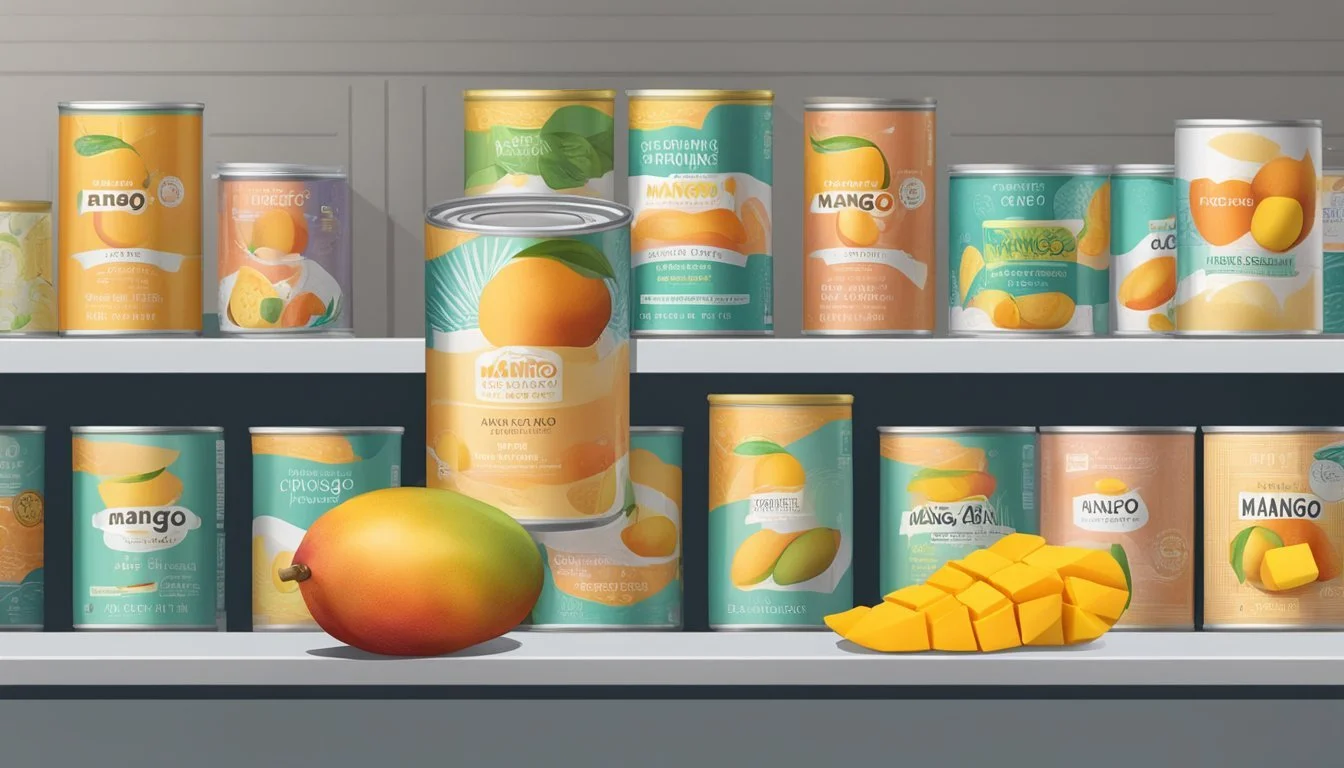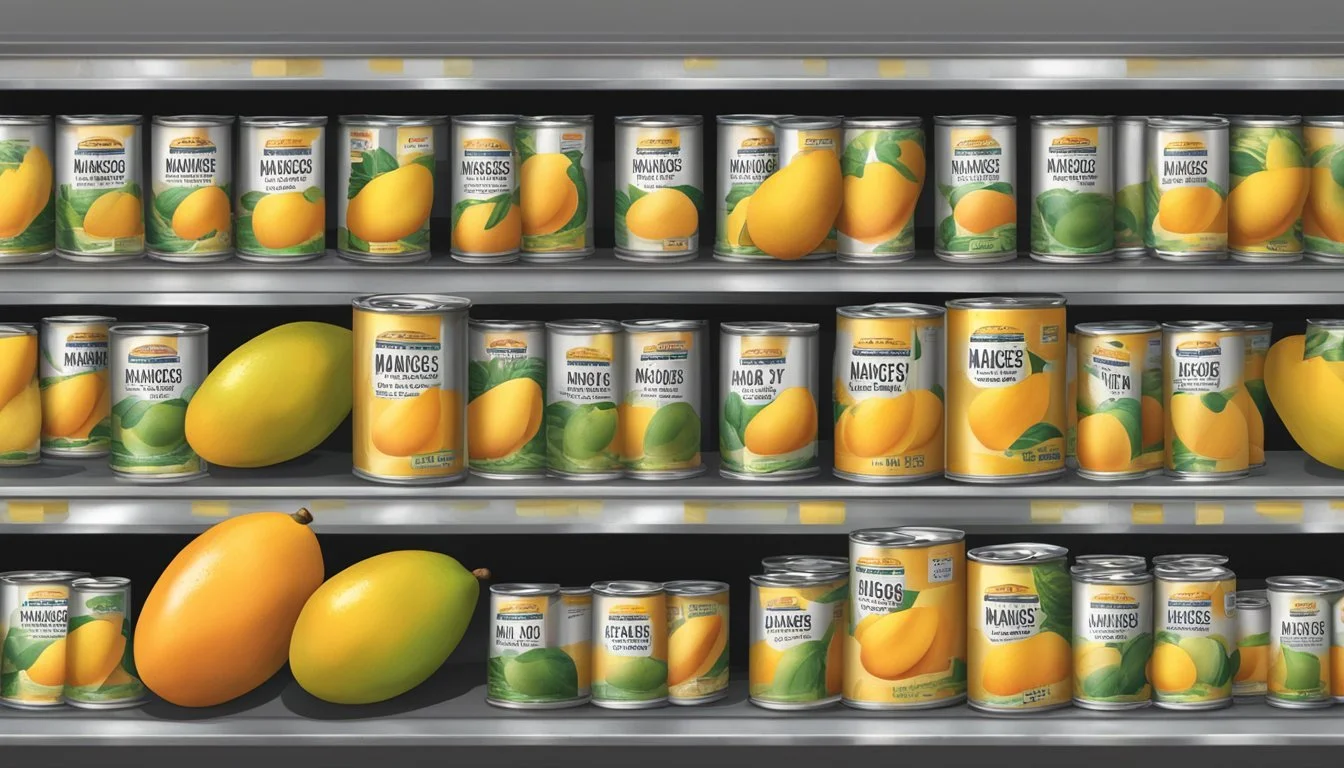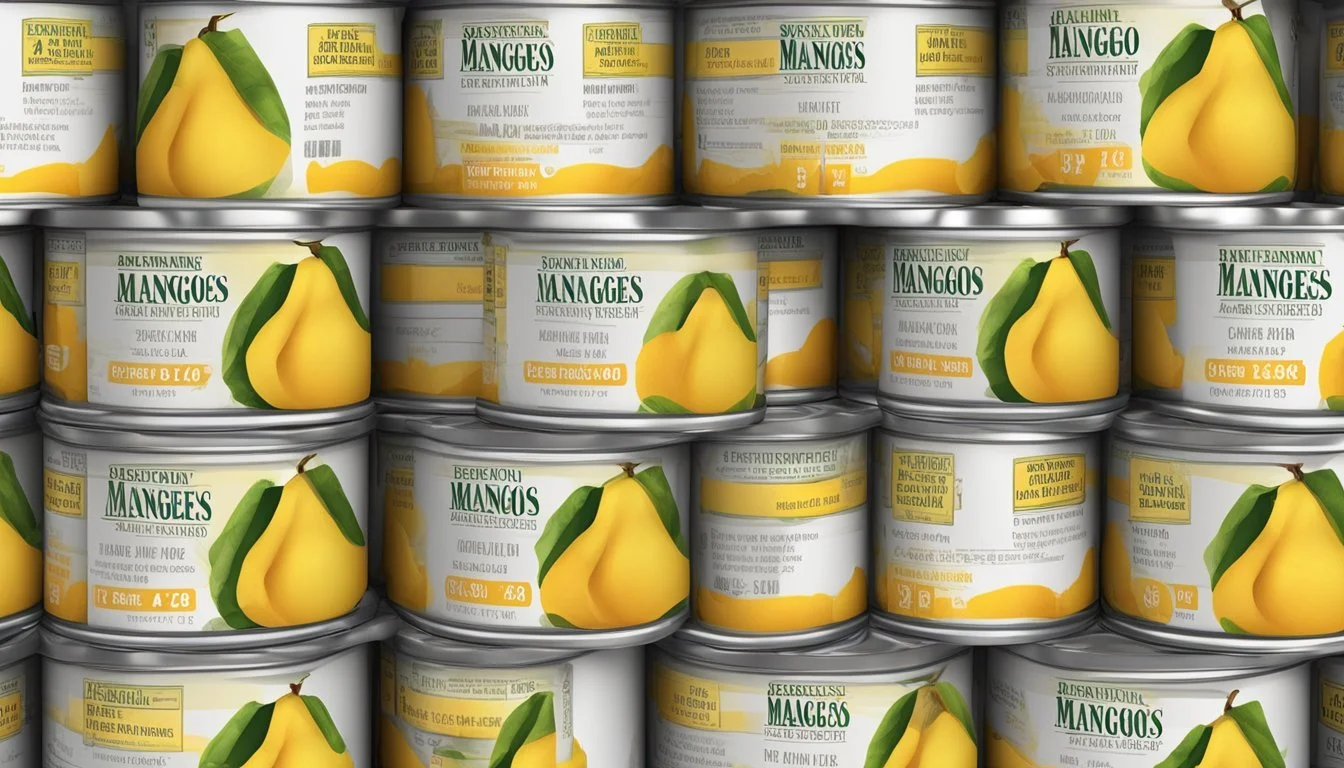Does Canned Mango Expire?
Shelf Life and Storage Tips
Mangoes are a beloved tropical fruit, known for their sweet and juicy flavor. When fresh mangoes are out of season or simply not available, canned mangoes provide a convenient alternative. Canned mangoes can typically last for at least 1-2 years beyond the expiration date on the can, as long as they are stored properly. This is due to the canning process, which preserves their quality and food safety for an extended period.
Over time, the quality of canned mango may diminish, affecting its texture and flavor, but it remains safe to eat if the can is undamaged and properly sealed. Paying attention to signs such as dents or rust on the can is crucial in ensuring food safety. While expired canned mangoes may still be edible, for the best taste and quality, consuming before the printed date is recommended.
By understanding how long canned mangoes last and how to check them, readers can enjoy this tasty fruit all year round without worry. This guide provides the essential information you need to make informed choices about consuming and storing canned mangoes.
Understanding Canned Food Expiration
Canned foods provide convenience, extended shelf life, and cost-effectiveness. Key factors to consider include expiration dates, food safety, and specific characteristics of canned mango.
Expiration Dates and Food Safety
Expiration dates on canned foods can be confusing. Terms like expiration date, best by, and use-by date all suggest different time frames for optimal quality.
Typically, high-acid foods, such as tomatoes, have a shorter shelf life compared to low-acid foods like meats and vegetables.
High-acid foods: 18 months after the "use by" date.
Low-acid foods: 2-5 years.
Food Safety: It’s important to check cans for any signs of damage, such as rust, dents, or swelling, before consumption to ensure safety. Damaged cans can compromise the food inside, leading to potential health risks.
Shelf Life of Canned Foods
Canned foods are designed to be stable and last long periods. When stored properly in a cool, dry place, their shelf life can extend beyond the printed date.
Unopened Canned Goods:
High-acid foods: Approximately 18 months.
Low-acid foods: 2 to 5 years.
Opened Canned Goods:
Typically, they should be transferred to a refrigerator and consumed within 7 days.
Always prioritize checking the condition of the can, such as its seals and the presence of rust, as part of the evaluation process.
Distinct Characteristics of Canned Mango
Canned mangoes, being a low-acid fruit, have a long shelf life. When stored correctly, unopened canned mango can remain edible for 2-5 years.
Once Opened: They should be refrigerated and consumed within a week.
Condition: Always ensure that the cans are undamaged to avoid spoilage. If the mangoes show any off smell or unusual appearance upon opening, they should not be consumed.
In summary, understanding and abiding by expiration guidelines and proper storage practices ensures that canned mangoes and other canned foods remain safe and enjoyable to eat.
Factors Influencing Canned Mango Preservation
Several factors, including storage conditions and temperature, seal integrity, and material degradation such as rust and dents, can significantly impact the shelf life and quality of canned mangoes.
Storage Conditions and Temperature
Proper storage is crucial for maintaining the quality and shelf life of canned mangoes.
Canned mangoes should be kept in a cool, dry place away from direct sunlight and heat sources. Exposure to high temperatures or humidity can accelerate spoilage. Ideal storage temperatures are typically between 50-70°F (10-21°C). Fluctuating temperatures can cause deterioration and affect the taste and texture of the mango paste.
Refrigeration is generally not necessary for unopened cans but can be beneficial to extend shelf life for opened cans. If opened, they should be transferred to airtight containers and stored in the refrigerator to prevent microbial growth.
Seal Integrity and Vacuum
The integrity of the seal is vital to prevent contamination and spoilage.
A proper vacuum seal ensures that no air and microorganisms enter the can, maintaining the mango's quality for longer periods. Signs of compromised seals include bulging lids, leaks, or any abnormal odors upon opening.
Consumers should avoid cans with any signs of bulging, as this may indicate that the vacuum seal has failed, potentially leading to bacterial growth. Always inspect cans before purchasing or using them to ensure they are properly sealed.
Material Degradation: Rust and Dents
Material quality, specifically the condition of the can, plays a significant role in preservation.
Rust can develop if cans are stored in damp or humid conditions, leading to potential contamination. Dents can compromise the structural integrity of the can, especially if they are severe. Severely dented cans are more prone to developing tiny holes and leaks, further allowing contaminants to enter.
It's essential to check for rust and dents before purchasing or using canned mangoes. Damaged cans should be discarded to avoid health risks. Ensuring the can remains intact and rust-free is key to preserving the mango's shelf life and quality.
Identifying Spoiled Canned Mango
Identifying spoiled canned mango involves checking for any signs of bulging or leaking in the can, assessing changes in odor and taste, and observing any alterations in the texture and color of the fruit.
Visual Inspection: Bulging and Leaking
One of the earliest signs that canned mango has gone bad is any visible bulging in the can. Swelling indicates that gas has accumulated inside, usually due to bacterial or yeast activity. This is a red flag for spoilage and the can should not be consumed.
Leaking also signals a problem. If the can is leaking juice, it likely has compromised integrity, allowing bacteria to contaminate the contents. Additionally, look for any signs of rust or corrosion, which can affect the quality of the mango inside.
Odor and Taste Assessment
A spoiled canned mango often emits an off odor. Upon opening the can, if the smell is sour, rotten, or just unpleasant, the mango is likely spoiled. The odor is a strong indicator and should not be ignored.
For taste assessment, take a small bite. If the mango tastes sour, bitter, or simply not how it typically should, it's best to discard it. Never consume canned mango with a taste that seems off as it could cause food poisoning.
Texture and Color Changes
Texture changes are another indicator of spoilage. Fresh canned mangoes should be firm but tender. If the texture is excessively mushy, slimy, or sticky, it has likely gone bad.
Color is also crucial to examine. While normal canned mangoes are usually vibrant yellow or light orange, spoiled ones may turn dull, dark brown, or even black. Any signs of mold on the surface also dictate that the mango is no longer safe to eat.
Always prioritize examining these aspects to ensure the quality and safety of the canned mango before consumption.
Health Implications of Expired Canned Mango
Eating expired canned mango can pose various health risks and also affect its nutritional value. The most common concerns are related to food poisoning and nutritional deterioration.
Botulism and Food Poisoning Risks
Spoiled canned mango can harbor dangerous bacteria such as Clostridium botulinum. This bacterium produces toxins that cause botulism, a severe form of food poisoning.
Symptoms of botulism include:
Blurred vision
Weakness
Difficulty swallowing
In severe cases, it can lead to respiratory failure. The risk of developing botulism increases if the can is damaged, swollen, or leaking. Hence, it’s essential to inspect cans for these signs before consuming any mango contents.
Additionally, spoilage can result in the growth of other harmful bacteria, leading to common food poisoning symptoms like nausea, vomiting, and diarrhea. Always trust visual and olfactory cues—if the mango looks or smells off, it’s unsafe to eat.
Nutritional Value Deterioration
Consuming expired canned mango can also mean a reduction in its nutritional benefits. Over time, the vitamins and minerals in canned mango degrade.
For example:
Vitamin C levels decrease
Antioxidants weaken
These changes mean that even if the mango isn't causing immediate harm, it’s providing fewer health benefits.
Storage conditions play a significant role in how quickly this degradation happens. Keeping canned mango in a cool, dry place can slow down the loss of nutrients. Nonetheless, consuming it before its expiration date ensures the highest nutritional value.
Ensuring proper storage and being mindful of expiration dates are crucial practices for enjoying canned mango safely and healthily.
Proper Storage Practices for Canned Mango
Proper storage practices are essential to maintain the quality and safety of canned mango. This means understanding where to store your unopened cans, how to handle them once opened, and how to effectively use freezing and refrigeration techniques.
Optimal Storage Locations
Unopened cans of mango should be stored in a cool, dry place, such as a pantry. Ensure that the storage area is away from direct sunlight and heat sources.
Temperature extremes can affect the integrity of the can and the quality of its contents. Aim to keep the pantry or storage area at a stable room temperature, ideally between 50-70°F. Humidity control is also vital; excess moisture can lead to corrosion of the can and potential spoilage.
Handling Opened Cans
Once a can of mango is opened, it must be transferred to an airtight container to maintain freshness. Store the container in the refrigerator at 32-40°F.
Avoid using the original can for storage in the fridge due to the risk of metal corrosion and possible contamination. Ensure that leftovers are consumed within 3-5 days. If you need to extend this period, consider freezing.
Freezing and Refrigeration Techniques
For long-term storage, freezing is an effective method. Transfer the mango to a freezer-safe, airtight container, leaving some headspace to allow for expansion.
Flash-freezing the mango pieces on a baking sheet before transferring them to a container can help prevent clumping. Keep the freezer at 0°F or lower. When properly stored, frozen mango can last for several months without significant loss of quality.
Maximizing Shelf Life and Quality
To ensure canned mango retains its best quality and freshness, it is essential to focus on proper storage practices and regular checks. Proper management can extend the shelf life of canned goods significantly.
First-In, First-Out Approach
Using a First-In, First-Out (FIFO) approach helps manage the inventory of canned goods effectively. This method ensures that older cans are used before newer ones, maintaining optimal quality.
Labeling cans with the purchase date allows for easy identification. Placing newer cans behind older ones in the pantry ensures older products are consumed first. This reduces the risk of cans becoming forgotten and maintains the freshness of mango paste.
Avoiding Extreme Temperatures
Canned goods should be stored at stable temperatures to maximize shelf life and quality. High-acid foods, like canned mango, are particularly sensitive to temperature fluctuations.
Ideal storage temperatures range between 50°F and 70°F (10°C and 21°C). Extreme temperatures, either too hot or too cold, can compromise the seal and quality of the cans. Storing cans in a cool, dry place ensures the best quality is maintained.
Avoid areas such as garages or attics, where temperatures can vary significantly. Ensuring a consistent room temperature helps preserve the mango's flavor and nutritional value.
Regular Inspection Routine
Regular inspections identify potential issues before they impact the quality of canned mango. Look for signs of rust, denting, or swelling on cans.
Checking expiration dates and rotating cans to use products before their best-by date is vital. Although canned goods often remain safe past their expiration date, quality can decline over time.
Inspect seals and ensure cans are airtight to prevent contamination. Any compromised cans should be discarded immediately to avoid health risks. Regular inspection routines help maintain the freshness and safety of canned mangoes.
By following these methods, the shelf life and quality of canned mango can be maximized, ensuring a reliable, tasty addition to meals for an extended period.
Leveraging Canned Mango After Expiry
Canned mango can often be safe to use even after the expiration date, thanks to the preservation process. Understanding the flavor changes and how to utilize it in recipes will help minimize waste and create delicious dishes.
Utilizing In Recipes
Expired canned mango can still be a useful ingredient in various recipes. For smoothies, mango nectar adds a rich taste without compromising safety. Puree the mango and mix it with coconut milk or yogurt for a tropical breakfast bowl.
Use it in baking for muffins, cakes, or bread, where the altered texture is less noticeable. In savory dishes, add it to curries or salsas where the mango's flavor can mingle with other ingredients. Even expired mango can shine in a chutney or marinade.
Understanding Flavor Changes
As canned mango ages, its flavor and texture may change. The fruit can become softer and more syrupy, which may affect its use in fresh applications. Instead, focus on incorporating it into cooked recipes where these changes are less perceptible.
Slight sourness may develop, so taste before adding sugar to adjust the sweetness balance. While the color might darken, it's usually more about aesthetics than safety. Always ensure the can is undamaged to avoid spoilage.
This approach helps extend the life of canned mango, reducing food waste and making the most out of grocery store purchases.








